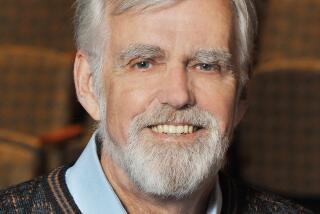BROADWAY’S LAST TRIBUTE TO BENNETT
- Share via
NEW YORK — Friends and colleagues who gathered here this week to memorialize Broadway director and choreographer Michael Bennett say his death this summer was part of a larger tragedy that has engulfed this city’s theater community--the tragedy of AIDS.
“He was one of the thousands of victims of this tragedy,” said Joseph Papp, Bennett’s producing partner on his long-running Broadway musical, “A Chorus Line.” Papp spoke near the conclusion of the moving, 90-minute memorial held Tuesday at the Shubert Theater. Bennett died July 2 at the age of 44.
“Not only people in the theater, but all kinds of people are dying from this plague,” said Papp, passionately exhorting the overflow audience in the 1500-seat theater to bring pressure on the federal government to increase efforts in the fight against AIDS.
The memorial for the man Papp called “Mr. Broadway” was the latest in what has come to be a frequent series of rituals for New York’s theater and arts community, which has been hard hit by the AIDS epidemic.
“It’s time for us to overcome this terrible disease that has taken my brother and so many others--with money, talent, time, prayer, or just love,” said Bennett’s brother, Frank DeFiglia, the first to refer directly to the disease that had cut short the life of the vital, energetic, inventive choreographer-director.
The untimely loss of Bennett and the void it has created in the Broadway theater was noted in the Shubert from the moment that “Chorus Line” composer Marvin Hamlisch stepped onto a bare, darkened stage to play “What I Did for Love,” from that Pulitzer Prize-winning musical. As a giant screen descended to reveal a film clip of Bennett, dancing as a very young child, the audience gasped.
Bernard Jacobs, another long-time friend and president of the Shubert Organization, called Bennett’s death “one of the great, genuine tragedies of the American theater.”
“All of us here were affected in some way by Michael,” said Bob Avian, who was Bennett’s longtime friend and colleague for 27 years. The two met while both were dancing in the chorus of a 1960 touring production of “West Side Story,” and eventually worked together on most of Bennett’s 15 Broadway shows.
“What he has shared through all of us will remain alive through us,” added Avian, who organized the memorial. “He’s still kicking, as long as we are.”
Other speakers referred to Bennett’s collaborative gifts, but they emphasized the more personal rather than professional nature of their relationships. Such words as “generosity,” “loyalty” and “love” were evoked often and some speakers indicated just how close they were to Bennett by noting his favorite color--red.
Among those who spoke, frequently choking with emotion, were Robin Wagner, a frequent set designer for Bennett’s shows; Liz Smith, the syndicated columnist, and Donna McKechnie, the dancer to whom Bennett was briefly married.
Musical tributes were offered by the Dreams, the singing trio that is the subject of Bennett’s last musical, “Dreamgirls,” and by Cleavant Derricks, an original cast member of that show. Composer Jimmy Webb sang one of his songs from what he said was a Bennett work-in-progress, with an apt lyric: “With 10 million men on this planet, how could one man make such a mark.”
One of the most moving moments of the program came when Stephen Sondheim accompanied himself at the piano singing what was said to be one of Bennett’s favorite songs--Sondheim’s “Move On” from “Sunday in the Park With George.” Sondheim, who rarely appears in public, much less performs, ended the song with a tearful, “Goodby, Michael.”
The tribute concluded with the current cast of “A Chorus Line” performing “One,” the triumphant, final number from Bennett’s signature show. As the cast members strutted, in their now-familiar glittering gold costumes and top hats, the mirrored panes that form the backdrop for the musical’s set turned to reveal an enormous portrait of Bennett, his arms outstretched, in front of letters spelling “DREAM.”
And the audience rose for one last ovation.
More to Read
The biggest entertainment stories
Get our big stories about Hollywood, film, television, music, arts, culture and more right in your inbox as soon as they publish.
You may occasionally receive promotional content from the Los Angeles Times.










